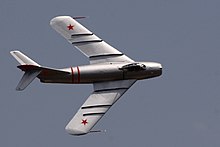Wing fence
This forces the nose of the aircraft up, increasing the angle of attack and leading to stall over a greater portion of the wing.
The result is a rapid and powerful pitch-up followed by a complete stall, a difficult situation for a pilot to recover from.
Similar solutions included a notch or dogtooth in the leading edge, as seen on the Avro Arrow, or the use of slats, as on the earlier versions of the F-86.
Slats can act as fences directly, in the form of their actuators, but also reduce the problem by improving the angle of attack response of the wing and moving the stall point to a lower speed.
[2] By 1947, after the introduction of subsonic swept wings, fences independently implemented in the USSR and the US: Lavochkin La-160, Mikoyan MiG-15, Northrop YB-49, McDonnell XF-85.




